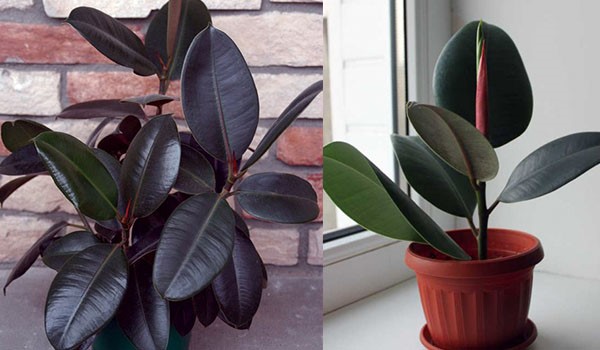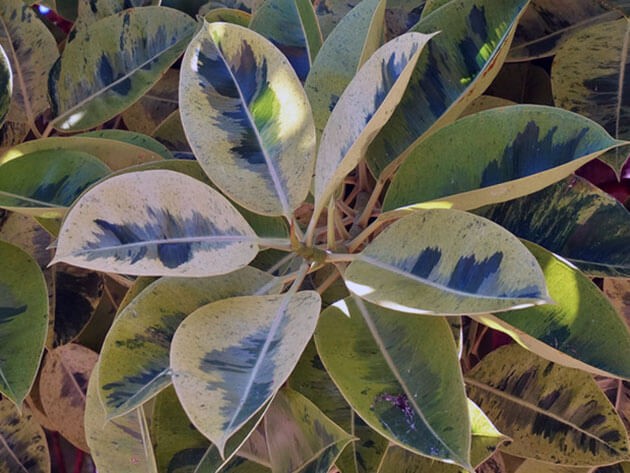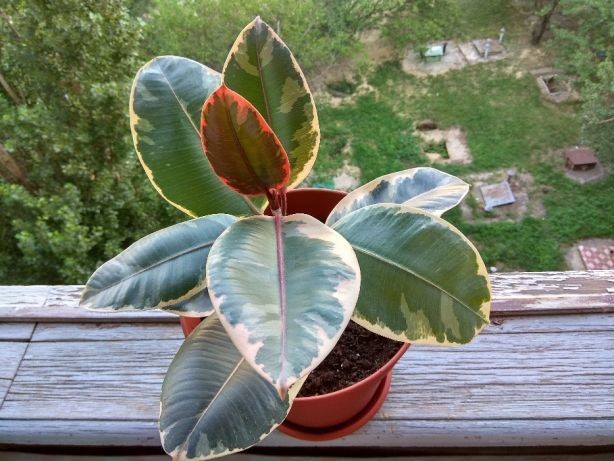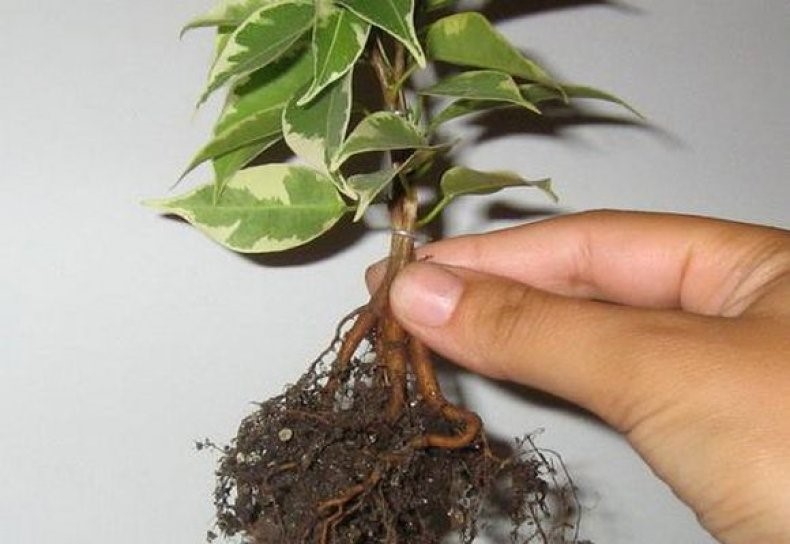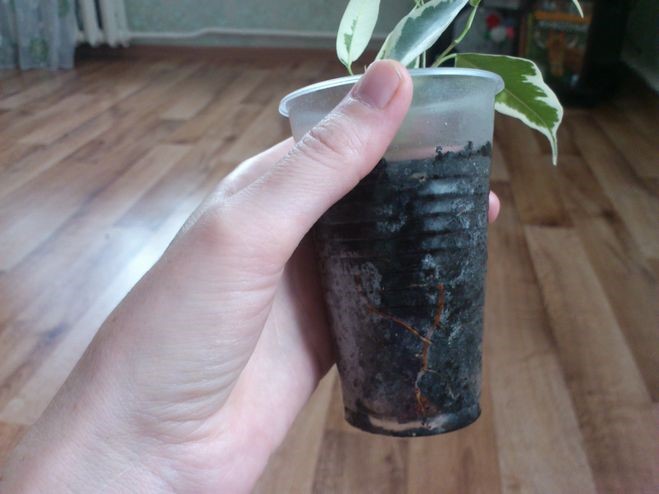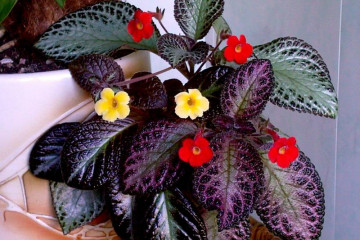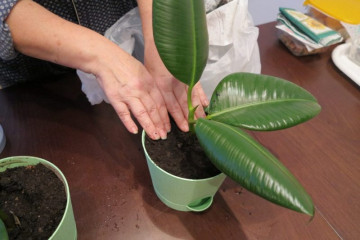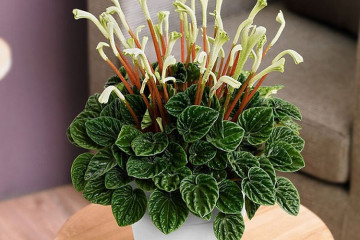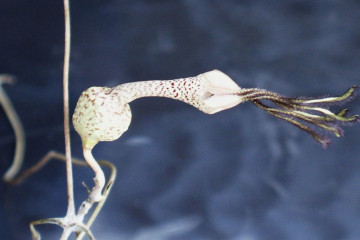Ficus rubbery - home care
Content:
The rubbery ficus, which is also called elastic or elastic, is one of the most popular decorative flowers. Even in ancient times, the ficus was considered the guardian of monetary and family well-being.
The origin and appearance of the plant
Northeastern India and Indonesia are considered the birthplace of ficus, on whose islands Java and Sumatra the flowering of this tree was first recorded. Plant height can be up to 30 m.
Ficus rubber has such a name due to the presence of thick juice in the stems and leaves. This juice is used to make rubber.
The beauty and strength of the flower is manifested in its sinewy and large leaves. At the beginning of the 20th century, when the fashion was for a pretentious and lush lifestyle, the ficus was not so popular. This is because the plant did not have distinctive external parameters, therefore it was quickly forgotten by the flower growers of that time.
Description of rubbery ficus
At the beginning of its growth, it resembles a single-stemmed tree with an undeveloped branching system. Prefers to be in a place filled with sunlight.
At the ends of the branches, aerial roots are formed, which in the process of development grow into trunks. Thanks to this method of growth, the ficus got the name "snake tree".
In length, the leaves reach 35-37 cm. They have the shape of an ellipse with a pointed end. The color of the leaves is dark green. Young leaves are scarlet and brown. From above, each sheet is covered with a thick skin. The inner juice is viscous and dense in consistency.
Such a culture is not picky, does not require a significant investment of time and money for care.
Types and varieties
Although it sometimes seems that all varieties of ficus are the same in care, this theory is erroneous. All varieties are outwardly different - in the shape and color of the leaves, branching methods, etc. Accordingly, each species has its own characteristics and rules of care.
Elastic
Ficus elastica is the most common type. The branches of this variety are formed gradually. When grown indoors, it does not give color. However, the leaves grow large, filled with sap.
Rubber ficus should be moistened only when clearly necessary. In the winter season, it rarely needs watering.
With active growth, a stick can be tied to the trunk of the plant. It will help the ficus grow up, and not to the side, without breaking the pillar itself.
Abidjan
A type of ficus that can be easily grown at home. It got its name from one of the cities in Africa.
It has a dark green leaf tint all year round. The leaf itself is round in shape with a sharp tip and a smooth surface.It measures 28 cm long and 20 cm wide. The stalk of the ficus is massive and thick.
It is worth watering as the soil dries up, with clean, or better, settled water.
Abidjan does not bloom in a room environment. For even stretching, pinch the upper stems. Ficus grows up to 50 cm per year, so this procedure is worth doing once every half a year. The transplant is carried out every 3-4 years.
Belize
Belize, as a species of ficus, was bred in artificial conditions. This method is also called variegated. Due to this mutation, ficus leaves are variegated, usually green, yellow, gold, brown, red. Colors smoothly transition from one to another. The flower itself is quite large-leaved from 23 cm in length and 15 cm in width.
This ficus loves bright sunlight, without direct exposure to rays, fresh air. In summer, Belize can be placed in front of an open window or taken out on the terrace. Water it as needed.
For transplanting, they use purchased soil intended for ficuses. It is filled with essential minerals that are needed for the full development of the plant.
Melanie
This type of ficus was bred relatively recently, in one of the greenhouses in Holland. Its origin is a consequence of the mutation of another species of ficus - Decor.
Melanie's ficus grows in width, not in height. Such growth makes it possible to independently control the size and shape of the crown. This can be done by pinching the extreme stem.
Perfectly adapts to the room environment.
Robusta
Ficus Robusta is a tall tree. This species is the only one of all that has such an active growth in height, thanks to the aerial roots that stretch upward. In the wild, the robusta ficus can branch and reach 60 m in height.
The leaves of the flower are dense, have a thick skin, a characteristic dark green color. Ficus elastica Robusta is worth buying only because it is able to cleanse the air from pollution, dust and toxic fumes.
Robusta is not picky. He is able to adapt to any conditions.
Black Prince
Ficus Black Prince is a special variety that has won many florists with its unusual color scheme: deep dark green leaves with a brown vein in the middle. Large leaves 25 cm long and 17 cm wide, elastic, have a shiny coating.
The Black Prince blooms actively in South Indonesia, West Africa and Asia. To maintain growth and external beauty, you can use the following tips:
- The black prince loves a lot of sunshine. It can be placed in a darker place, but the leaves will not have a saturated color, growth will slow down a little.
- Water it only when the top layer of the soil dries up by 2 cm.
- Fresh warm air will be good for the plant, but don't keep it in a draft.
- It is enough to replant a young ficus once a year, a more mature plant once every 3 years.
- You should regularly wipe the leaves from dirt and dust.
- Fertilizer should be given in spring.
Sriveriana
Ficus Sriveriana is one of the cultivars grown in culture in Belgium in 1957.
The leaves of the plant are thinner than those of the closest relatives. The leaf itself is ellipsoidal, with a marbled color of dark green, light green, yellow and mustard colors. The structure of the leaf is cut with veins. The stem has a yellow tint.A standard sheet is 24 cm long and 18 cm wide.
The variety requires a lot of heat, light and moisture.
Tineke
Ficus Tineke, with proper care, can reach gigantic proportions. Has a yellow border on the edge of the sheet. According to its characteristics, it fully corresponds to the ficus of the Elastic type.
Tricolor
Basically, variegated ficuses require careful care, but not Tricolor. Its leaves combine three colors: a brown stem, a green center and yellow edges. New leaves have a pink tint, but over time it disappears.
Tricolor actively absorbs sunlight, due to this, the color is formed. Without it, the leaves will lose their elasticity.
Decor
The decor has large sheets of 30 cm in size, cut with veins. The middle of the leaf is yellow, sometimes brown or pink, smoothly turns into green. The edges of the leaf are folded down.
Transplanting rubbery ficus after purchase into a pot
Before buying, you should carefully study the flower: the soil should be clean, without mold, young roots, fresh leaves. You can plant and grow a flower at home.
What is needed for landing
Prepare a new pot that is at least 3 cm larger than the old one. You will also need soil for ficus, soot or coal, expanded clay.
Choosing the best place
The place should be sunny, warm, draft-free. The east or west side is perfect.
Step-by-step planting process
A transplant is possible after 2-3 weeks of adaptation in a new place. They do it this way:
- A little coal is added to the already prepared soil mixture.
- Cleanses the root system from excess. The damaged areas are sprinkled with coal soot.
- Transfer the plant to a new pot, cover with earth until the beginning of the root collar.
- Expanded clay is placed at the bottom of the pot to strengthen the root system.
The new plant is watered after 4-6 days.
Leaves may fall off after transplanting - this is normal. The ficus will not take root quickly, it will take time.
Reproduction of rubbery ficus
If you do not know how to root a ficus with large leaves, try one of the traditional methods: leaves and cuttings.
Propagation by cuttings
When the ficus is too grown, the upper part is cut off. Even when cut, it is suitable for reproduction. Cutting is perfect for planting a new plant. How to plant:
- The stalk (tip) is well washed from the milky juice.
- The lower leaves are tucked inward and slightly tied up.
- A cutting is not planted in the ground much, per internode.
- Water abundantly.
Growing from a leaf
For cultivation, you will need one leaf with a bud. It is she who serves as a point for the growth of the root system.
Cultivation:
- Expanded clay is placed at the bottom of a plastic cup and holes are cut for draining excess water.
- Sprinkle with loose soil so that the kidney remains on the surface.
- A wooden stick is used to support the plant.
- Water the soil.
- A plastic bag is put on top to create a greenhouse effect.
- They wait 4-5 weeks for the leaf to form a root.
Both methods are effective, but which will be faster depends on the soil and climate. Damaged or broken roots cannot be made to grow. You need to take care and shape the plant constantly so as not to miss the moment of transplantation.
Caring for rubber ficus at home
Only some varieties of ficus require special care.
Watering mode
For normal growth, it is worth moistening the soil only when the soil dries to a depth of 2 cm or 2 fingers. Depending on the season:
- in the summer - 1-2 times a week;
- in winter 1 time in 10-14 days (look at the state).
The sheets should be wiped once a week; with the windows open, you can repeat the procedure more often. With abundant watering, the leaves begin to turn yellow and fall off. All damaged leaves must be cut off.
Top dressing
Top dressing is an important factor in flower development. It is worth fertilizing the land in the period from early April to late September 2 times a month. For this, you can use mineral and organic additives. Water only the soil, do not contact foliage.
Preparing for winter
With the onset of the cold season, the ficus should be moved as much as possible to sunlight without exposing the leaves to cold air. Do not use cold water.
Ficus is a simple, beautiful and useful flower. Due to its cleaning properties, it can filter indoor air. It does not accumulate harmful substances, but processes them into sugar and amino acids.


